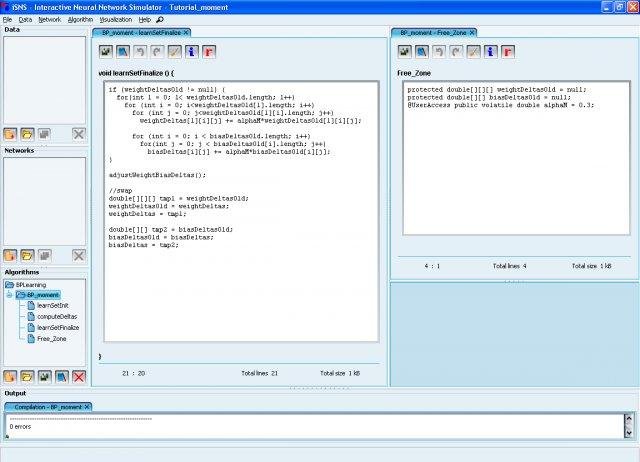Simulating Neural Networks With Mathematica Download Trial

A backpropagation neural network (BPN) was used to identify bacterial plant pathogens based on their genomic fingerprints. Genomic fingerprint data, comprised of complex DNA band patterns generated using BOX, enterobacterial repetitive intergenic consensus (ERIC) and repetitive extragenic palindromic (REP)‐primers (rep‐PCR), were used to train three independent BPNs. 10 Strains of the genus Xanthomonas, each with a characteristic host plant range, were identified correctly using the three trained BPNs. When tested with fingerprints of bacterial strains not present in the training sets, the rejection rate was 100%, using the three BPN classifiers combined.
Thus, BPN protocols can be employed to generate a powerful computer‐based system for the identification of pathogenic bacteria in the genus Xanthomonas. 1Introduction Bacterial plant pathogens can be difficult to identify in a timely manner. This is particularly true for strains classified within the genus Xanthomonas, which are able to cause disease on over 390 plant species. The genus comprises over 140 distinct pathogenic lineages that in many cases cannot be reliably differentiated for phylogenetic classification purposes by their cellular metabolism or other phenotypic characteristics. Strains within a taxon are differentiated primarily on the basis of the plant host that they parasitize or by the type of symptoms produced on a diseased host plant. The taxons are named at the species level based on DNA homology experiments or at the subspecies level as pathogenic variants or pathovars.
However, with the advent of DNA‐based genotypic analysis methods, major advances in the reliable differentiation and classification of these host‐adapted strains has been made. For example, it has recently been shown that repetitive DNA sequence‐based polymerase chain reaction (rep‐PCR) genomic fingerprinting can be used for the identification and classification of Xanthomonas species/pathovars. Rep‐PCR makes use of repetitive elements dispersed throughout the chromosome of diverse bacterial species, as primer sites for PCR, generating amplicons of distinct sizes to generate specific genomic fingerprints of each Xanthomonas species or pathovar.
Installed robotc 3.62 and when connected the ev3 nxt to the USB port and attempted to download Firmware, the NXT brick did not show up on the download firmware window.what am I missing? RobotC 3.62 Full Free with virtual worlds and Skyrise Pack (Keyg. RobotC for Lego Mindstorms 3.04 + Tsrh Keygen. Uploaded, Size 78.42 MiB, ULed by cubicsquare. 9.3 62 rifle cartridge. Posted by: Xander September 8, 2013 in ROBOTC Comments Off on New Release: ROBOTC 3.62. This is most likely the last 3.x ROBOTC release. It fixes a couple of things, you can find the list of changes below. Stream ytcracker - crack cocaine by ytcracker from desktop or your mobile device.
In this report, primers targeting the highly conserved repetitive sequences from the BOXA subunit of the BOX element of Streptococcus pneumoniae (BOX), enterobacterial repetitive intergenic consensus (ERIC) and repetitive extragenic palindromic (REP) sequences, were used in rep‐PCR reactions ( and references therein) to generate genomic fingerprints of 24 Xanthomonas strains, comprising 10 pathovars within seven of the 20 species, as described. A backpropagation neural network (BPN) is a connectionist network that can be trained to identify complex patterns. The neural network approach has been applied successfully for pattern identification in several areas of biological research. Examples of such applications are the protein classification artificial neural system developed by Wu et al., backpropagation and counter propagation neural networks for phylogenetic classification of ribosomal RNA sequences developed by Wu and Shivakumar and a neural network for classification of mass spectra developed by Curry and Rumelhart.
Bungay and Bungay as well as Rataj and Schlinder have used neural networks for the identification of bacteria at the beginning of this decade. These explorations were continued by Chun et al. Who used artificial neural network analysis of pyrolysis mass spectrometric data in the identification of Streptomyces strains.

Readers will learn how to simulate neural network operations using Mathematica and will learn techniques for employing Mathematics to assess neural network behaviour and performance. Neural networks approach the problem in a different way. Sigmoid neurons simulating perceptrons. If you don't use git then you can download the data and code here.
Carson et al. Oce tds450 driver windows 7. Explored the recognition of pathogenic Escherichia coli O157:H7 PFGE restriction patterns by artificial neural network and Goodacre et al. Used infrared spectroscopy and artificial neural networks for rapid identification of Streptococcus and Enterococcus species.